An invasive species is an animal or plant that comes from another part of the world and does not belong in California. They are introduced by people, accidentally or they come in ship ballast water. There are sixty-seven invasive species in California.
If you want to know if the plant in your yard is invasive or what animals are causing problems to native animals, continue reading to find out more.
Table of Contents
Invasive Animals of California
There are thirty-seven invasive animals in California, these include:
1. Banded Water Snake

The Banded Water Snake (Nerodia fasciata) is a nonvenomous, aquatic snake that can grow to 107 centimeters in length. This gray, green-brown, or brown snake has dark cross bands. The belly is white.
This snake has a flat head and is heavy-bodied. There is a dark stripe that runs from the eye to the jaw. When irritated, they release a foul odor that deters predators. These snakes live in freshwater environments, including ponds, streams, marshes, and lakes.
It was discovered in three sites in California in 1992 and by 2008, there were more than three hundred banded water snakes caught in Los Angeles.
2. Northern Watersnake

The Northern Watersnake (Nerodia sipedon) is a large, non-venomous snake that can grow to 135 centimeters in length. These snakes are brown-black, brown, gray, or red with dark cross bands on the neck and dark patches on the body. They are often mistaken as copperheads or cottonmouths.
The snake is harmless to humans. They have flat scales on the head. They were introduced to California in 1992 and are considered an invasive species. They compete with the giant garter snake.
3. Red-eared Slider

Red-eared Sliders (Trachemys scripta elegans) are semi-aquatic turtles and popular pets in the United States. It is the most invasive turtle and the most commonly traded turtle throughout the world. It is native to the Midwestern United States but has been established in California by pet release.
It competes against native species and is included in the world’s 100 most invasive species. The carapace can reach 40 centimeters in length. Females are larger than males and they can live for up to thirty years.
The shell has an upper and lower carapace. The carapace is oval and flat. The color of the carapace is variable with most being dark green with light and dark patches.
4. Brown Anole

The Brown Anole (Anolis sagrei) is a lizard, native to the Bahamas and Cuba. It has been imported by accident in plants, where the anole has laid eggs in the soil of plant pots. They are highly invasive reaching high population densities. They can expand their range very quickly, competing against native lizards.
This lizard is light brown with dark brown and black markings on the back. There are tan lines on the side. They have a yellow to orange-red dewlap. The brown anole can grow to 20 centimeters in length.
5. Jackson’s Chameleon
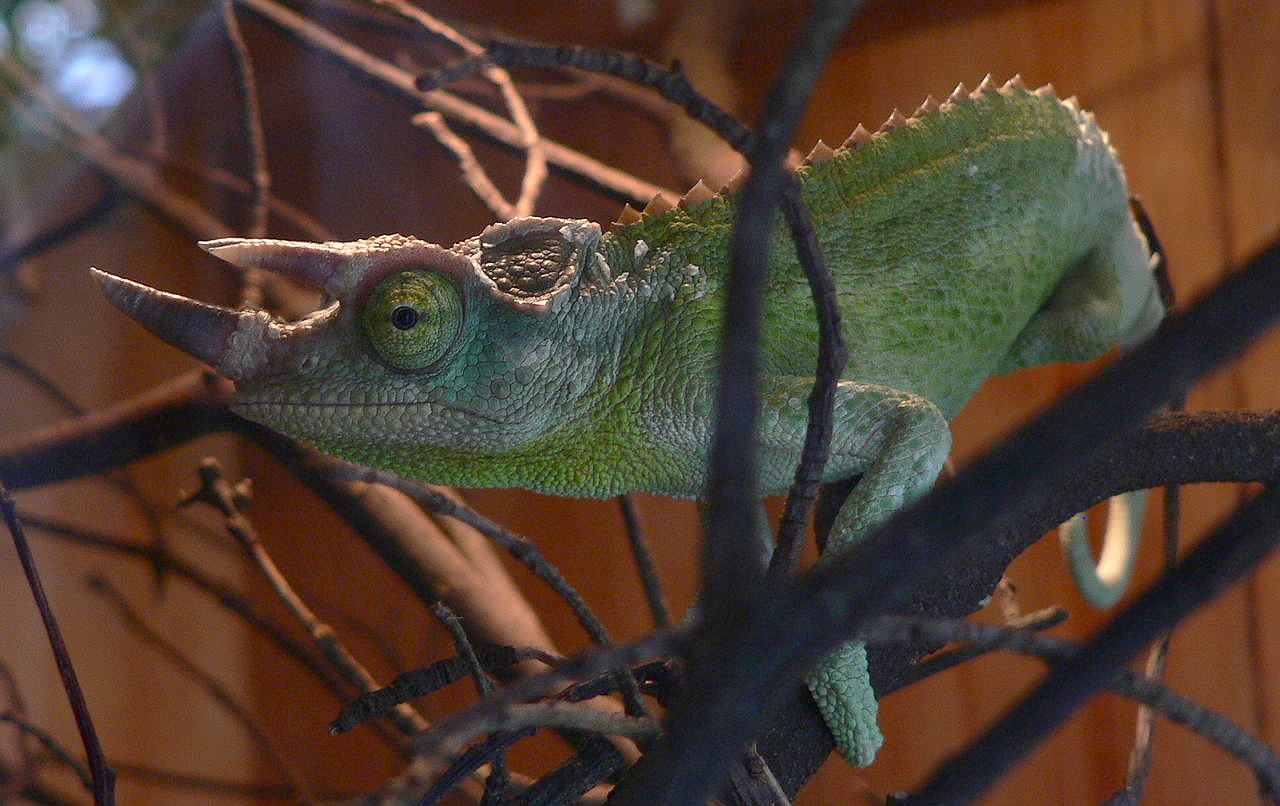
The Jackson’s Chameleon (Trioceros jacksonii) is native to East Africa and has been introduced to California. These are also known as three-horned chameleons. The males have three brown horns, one on the nose and one above each orbital ridge over the eyes. The females do not have horns.
This is a bright green chameleon with some having blue and yellow color traces. They change color based on temperature, health, and mood. Males can grow to 38 centimeters and females to 25 centimeters.
6. Italian Wall Lizard
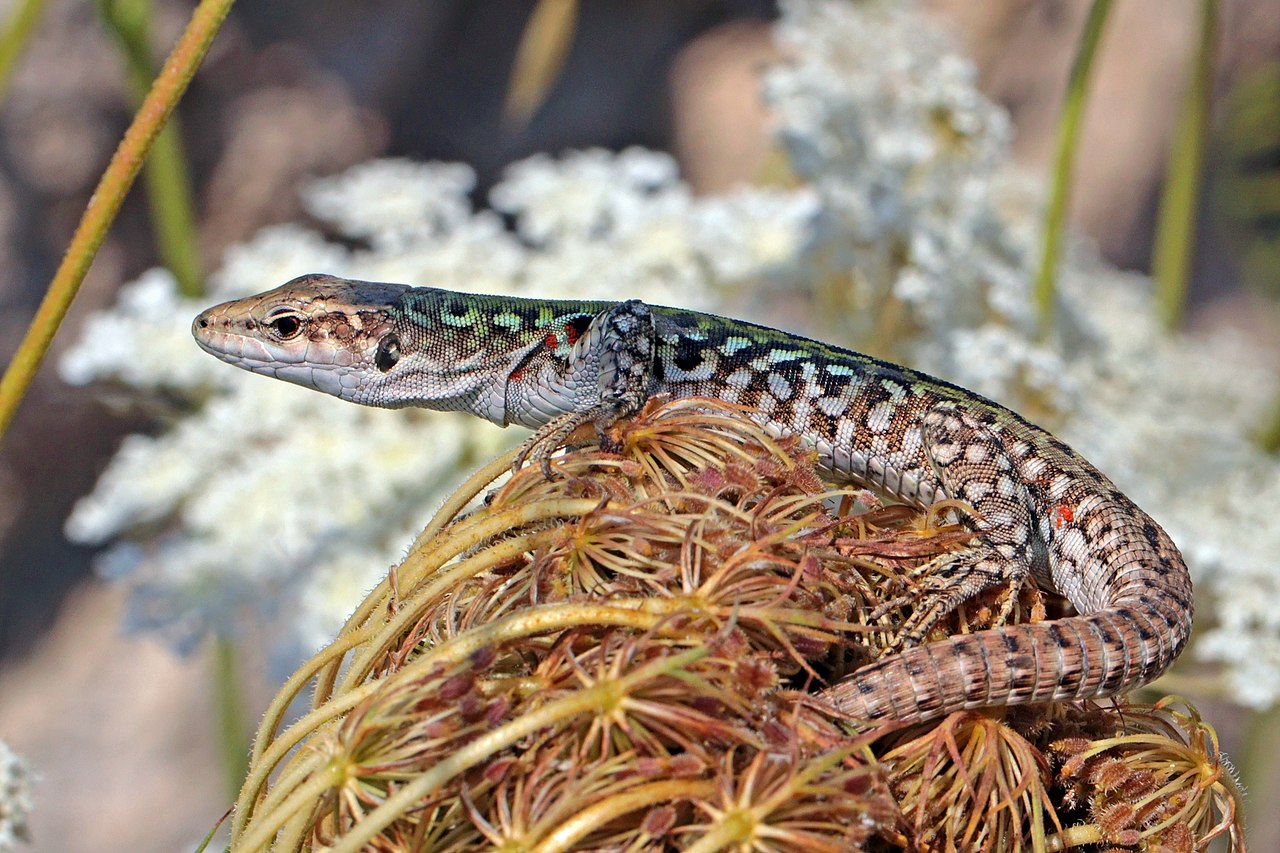
The Italian Wall Lizard (Podarcis siculus) is native to Bosnia, Italy, Croatia, France, Slovenia, and Switzerland. It thrives in the wild and captivity with a generalized diet, which allows it to have a large range.
This lizard is green or black-brown with a white or green belly.
7. Mediterranean House Gecko

The Mediterranean House Gecko (Hemidactylus turcicus) is also known as the Turkish gecko. This gecko is nocturnal and feeds on insects. They grow to around 15 centimeters in length with large eyes.
They are tan or purple with black spots. There are often stripes on the tail. The belly is translucent. Their numbers are increasing and they are resistant to pesticides. They shelter in cracks or unseen areas in human habitats.
This gecko has spread throughout the world, establishing stable populations.
8. Spiny Softshell Turtle

The Spiny Softshell Turtle (Apalone spinifera) is one of the largest freshwater turtles in North America. It has a flexible, leathery carapace and webbed feet with three claws. They also have elongated noses, which helps in identification.
Their color ranges from yellow-brown or brown to live. There are pale lines with black borders that run from the head down the side of the neck. The carapace can be up to 54 centimeters. Females are larger than males.
There are spines down the border of the carapace, which is more common in males.
9. American Bullfrog
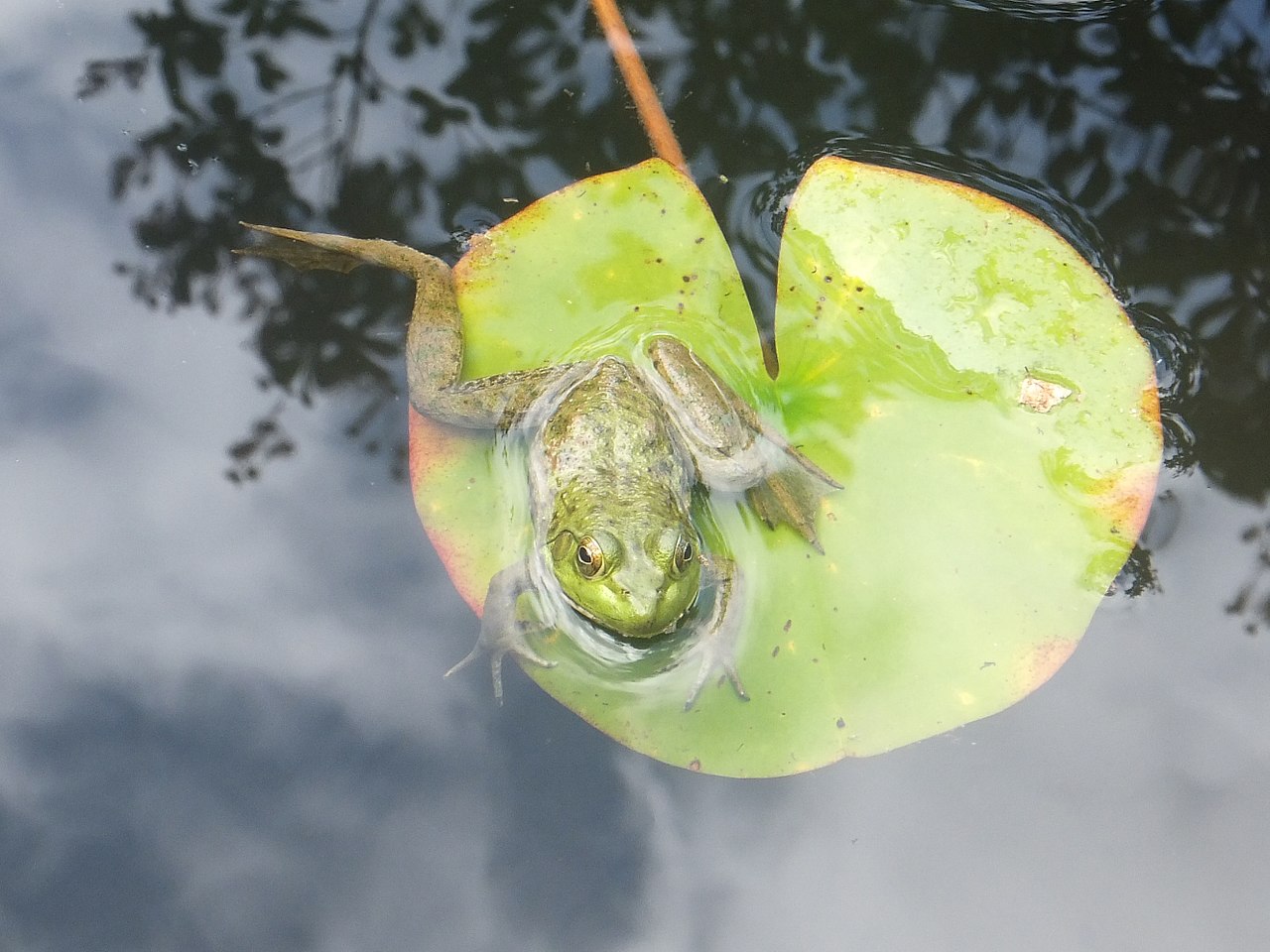
The American Bullfrog (Lithobates catesbeianus) is a large true frog, native to eastern North America. It lives in permanent water, including swamps, lakes, and ponds. They are also found in manmade habitats, including koi ponds, ditches, canals, and swimming pools.
During mating season, this frog makes a bull bellowing noise, which is where they get its name. They have been distributed outside their native range and are considered an invasive species with a voracious appetite.
They produce a large number of eggs, harming native amphibians and fauna. They are skittish and difficult to capture. This olive-green frog can be plain or have mottled coloring with gray-brown banding. The belly is off-white with gray or yellow patches.
10. African Clawed Frog

The African Clawed Frog (Xenopus laevis) is an African aquatic frog that has three claws on each hind foot. These claws are used to tear apart food. They are native to Sub-Saharan Africa and have been introduced to California.
They are tongueless and toothless. They are completely aquatic with powerful legs for swimming. They are scavengers and will eat anything, including organic waste, or anything alive, dead, or dying.
They are plentiful in ponds and rivers. They are green-gray and are often sold as pets and are highly adaptable, surviving up to thirty years in captivity and fifteen years in the wild.
11. Black Rat

The Black Rat (Rattus rattus) is a long-tailed rodent that originated in India. Today it has been introduced throughout the world. They are light brown to black with a light underside. It is an omnivore and a pest to farmers, feeding on crops.
It is confined to warm areas and is larger and more aggressive than the brown rat. Their populations have increased exponentially.
12. Nutria

The Nutria (Myocastor coypus) is a large, semi-aquatic, herbivorous rodent. It belongs to the family of spiny rats. They live along stretches of water, feeding on plant stems. They are originally from South America.
It is an invasive species, known for its destructive feeding and burrowing habits. They can also transmit disease to animals and humans through water contamination. They resemble a beaver or large rat with a small hairless tail.
They can grow to sixty centimeters in length and weigh up to nine kilograms. They have three sets of fur and webbed hind feed. They were first introduced to the United States in 1899 in California.
13. Fallow Deer

The Fallow Deer (genus Dama) is a European deer, native to Turkey. Adult males can grow to 160 centimeters long, females can grow to 150 centimeters in length. Their lifespan can be up to sixteen years.
There is a lot of variation in their coat coloring. White is the lightest and most common color, some are darker, and others are sometimes black, confusing them with sika deers.
14. Chital

The Chital (Axis axis) is a spotted deer. These are moderate-sized deers, growing to ninety centimeters in males and seventy centimeters in females. The males have antlers, the females do not.
They are golden with white spots. The tail, ears, inside of legs, throat, and rear are white. The antlers are three-pronged and can be up to one meter in length. They were introduced in Texas in 1932 and were found throughout California by 1988.
15. Common Starling
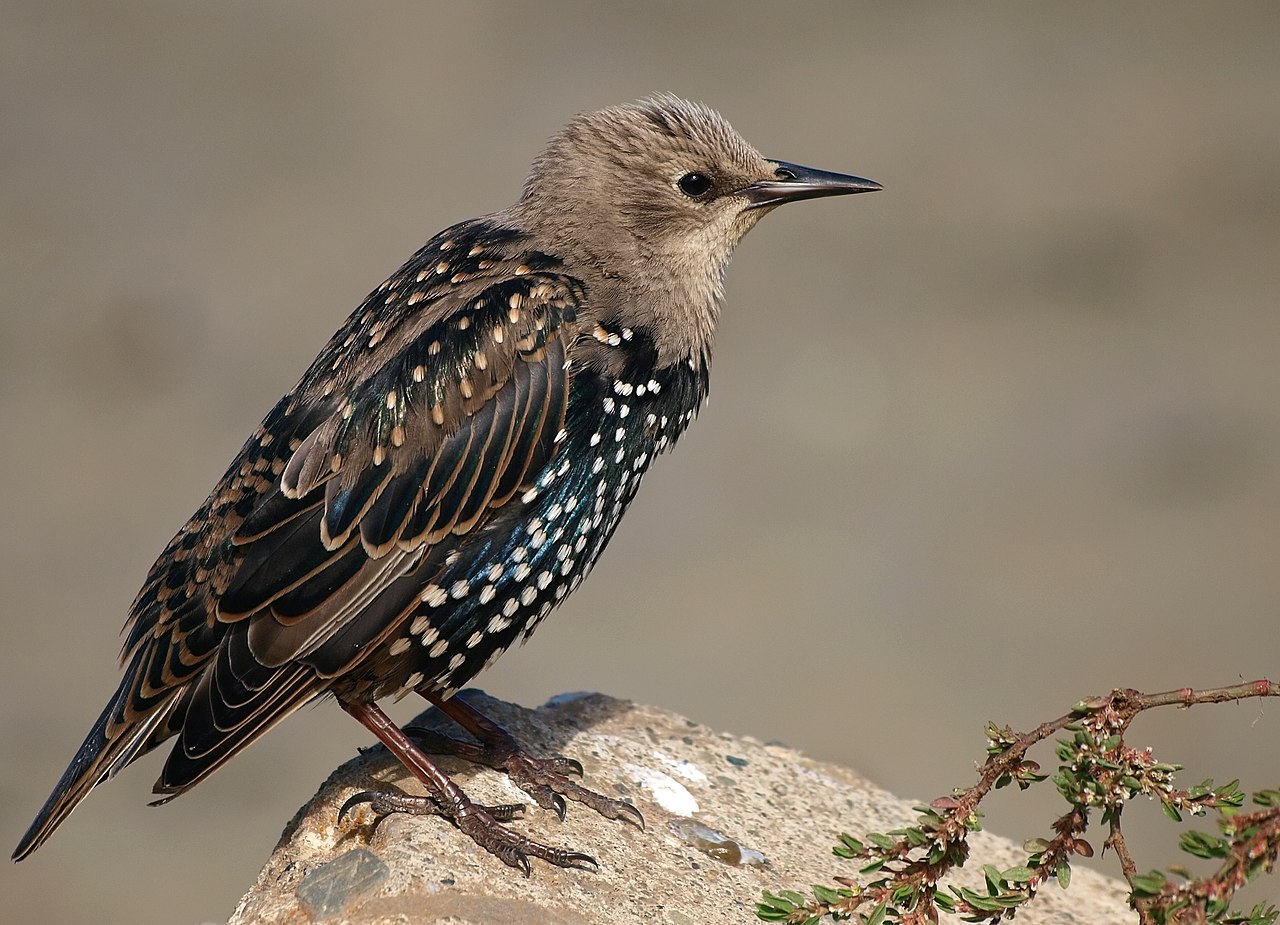
The Common Starling (Sturnus vulgaris) is a European starling. It is a medium-sized bird, growing to 20 centimeters in length with glossy black feathers. They have pink legs. They were introduced to New York, Quebec, and Cincinnati in the 1870s.
Sixty common starlings were introduced by the presidents of the American Acclimatization Society in New York’s Central Park in 1890. He tried to introduce all the bird species mentioned by William Shakespeare. The Portland Song Bird Club released thirty-five common starlings in Portland around the same time. Today there are an estimated one hundred and fifty million common starlings in North America.
16. Red-masked Parakeet

This (Psittacara erythrogenys) is a medium-sized parrot native to Peru and Ecuador. It is a popular pet and an excellent talker. They can grow to 33 centimeters in length, half of which is the tail. They are green with a red head. The under wings are red and some have red on their necks.
They live in the jungles and forests in Peru and Ecuador, thriving in semiarid areas and suburban areas. They are widely distributed and due to their popularity as pets, they have been introduced to California through accidental release.
17. Mute Swan

Mute Swans (Cygnus olor) are waterfowl, native to Eurosiberia and Africa. They were introduced to North America, where they have the largest population outside their native range. These swans are less vocal than other swans, growing to 160 centimeters in length.
They are white with an orange beak with a black border. There is a knob on the top of the beak. It is one of the heaviest flying birds.
18. Rock Dove

The Rock Dove (Columba livia) belongs to the Columbidae family, often called the pigeon. They are escaped domestic pigeons, increasing populations throughout the world to become feral pigeons. This is a pale gray bird with two black bars on each wing.
They inhabit open and semi-open environments and are often seen on rock ledges. This bird has escaped domestication. They can grow to 37 centimeters in length with a 72-centimeter wing span. The head is blue-gray with a glossy yellow, green, or red-purple chest.
19. House Sparrow

The House Sparrow (Passer domesticus) is a small bird, growing to 16 centimeters in length. The female and younger birds are pale brown and gray. Males have white, brown, and black markings. They are associated with human habitats, living in rural and urban areas.
They avoid woodlands, grasslands, and deserts. They feed on seeds from weeds and grains. They are opportunistic eaters, eating insects and other foods. They are very prominent in California and are agricultural pests.
They have adapted to live with humans in a range of conditions, making their populations stable in non-native regions. They can extend their range very quickly by more than 230 kilometers each year. They pose a threat to native birds.
20. Eurasian Collared Dove

This dove (Streptopelia decaocto) is native to Europe and Asia and was introduced to North America, increasing its population. This is a medium-sized dove with a long tail. They grow to 32 centimeters in length with a 55-centimeter wingspan.
They are gray or pink-gray with a blue-gray under the wing area. The tail feathers are gray with white below. They have short red legs and a black bill. They make loud screeching calls that last two seconds, often when flying just before they land.
They escaped captivity in Nassau, Bahamas, and spread to Florida. Today they can be found in almost every state in the United States.
21. Warbling White-eye

The Warbling White-eye (Zosterops japonicus) is a small bird, native to East Asia. It was intentionally introduced as a pet and for pest control. This bird is olive green with a pale green underside. The feet, bill, and legs can be brown or black.
The forehead is green with a yellow throat. They have a slender bill and rounded wings. They can grow to 11 centimeters and weigh 12.75 grams.
22. Lilac-crowned Parrot

The Lilac-crowned Parrot (Amazona finschi) is endemic to Mexico. It is also known as Finsch’s amazon and has green feathers, a maroon forehead, and violet-blue on the neck and crown. They are on the IUCN endangered species list as of 2014.
There is a growing population of around one hundred lilac-crowned parrots in Southern California, mostly in Orange County and the San Gabriel Valley.
23. Yellow-headed Parrot

This parrot (Amazona oratrix) is an endangered amazon parrot from Mexico. They grow to 43 centimeters in length. It is a short-tailed and stocky green parrot with a yellow head. They prefer living in mangrove forests close to water.
This is a popular pet and an excellent talker. They have a robust build, square tails, and rounded wings. The bill is gray and they have a white eye ring. They give a low-pitched, almost human scream.
They live in the riparian forests and evergreen forests of Belize and the mangroves in Guatemala. They were introduced to Southern California.
24. Snakehead

The snakehead (family Channidae) is a freshwater fish, native to Africa and Asia. They are elongated fish with long dorsal fins and large mouths. They are predators and can migrate short distances over land.
They are a valuable food source and were intentionally released. They are an invasive species kept as pets. When they get too big they are released into rivers, lakes, and ponds.
Some of the snakehead species can grow to more than one meter in length. They feed on aquatic insects, mollusks, and plankton. They also feed on frogs and other fish.
25. East African Lowland Honey Bee

This (Apis mellifera scutellata) is a subspecies of the western honey bee, native to Africa. They are similar in appearance to the European bee but slightly smaller. The upper body is covered in fuzzy hair with a striped abdomen.
They were imported to Brazil, spreading into Central and South Africa and then into North America. They thrive in tropical areas.
26. Oriental Fruit Fly

The Oriental Fruit Fly (Bactrocera dorsalis) is a destructive pest. Native to tropical Asia, they have established themselves in the United States, where they were accidentally introduced in the 1940s.
They were eradicated in California between 1960 and 1997. An infestation was detected in 2002 and 2004. Eradication programs were set up again in 2006 and 2007.
These are larger than house flies and can grow to 8 millimeters in length. Their color varies from yellow to black or dark brown. The abdomen has two black stripes and a median stripe, forming a T-shape. They have a slender and pointed ovipositor.
27. European Green Crab

The European Green Crab (Carcinus maenas) is a common crab known as the shore crab in the British Isles and the European Green Crab in North America and South Africa. It is a widespread invasive species and is on the one hundred world’s worst alien invasive species list. It is native to the Baltic Sea and the Atlantic Ocean.
They can grow to 90 millimeters, feeding on worms, small incrustations, and mollusks. They affect fisheries. They have dispersed on the hull of ships, packing materials, and seaplanes.
The carapace has five teeth on the rim, just behind the eye. They can be red, gray, brown, or green. Red crabs are more aggressive and stronger.
They were first found on the east coast of North America in 1817. They have extended their range and were found in San Francisco Bay, California in 1989.
28. Asian Clam

The Asian Clam (Corbicula fluminea) is a freshwater clam native to eastern Asia. It is a successful invasive species in North America. They can remove up to seventy percent of the phytoplankton biomass in invaded rivers, they also decline dissolved oxygen in the water.
They have cost billions of dollars due to clogged plumbing, heat exchanges, and other human infrastructure over the years, causing economic and social impacts due to their invasion.
29. Chinese Mitten Crab

The Chinese Mitten Crab (Eriocheir sinensis) is also known as the Shanghai hairy crab. These are medium-sized burrowing crabs that live in rivers and estuaries, along with coastal habitats. They are native to East Asia and were introduced to North America, where they are an invasive species.
The body of the crab is the size of a human’s palm. The legs are double the length of the carapace, which is around ten centimeters in width. They spend their lives in fresh water and return to the sea in the breeding season. They prefer brackish water for larva development.
They are omnivores, feeding on mussels, snails, worms, incrustations, fish, and dead organic materials.
30. Polyphagous and Kuroshio shot hole borers
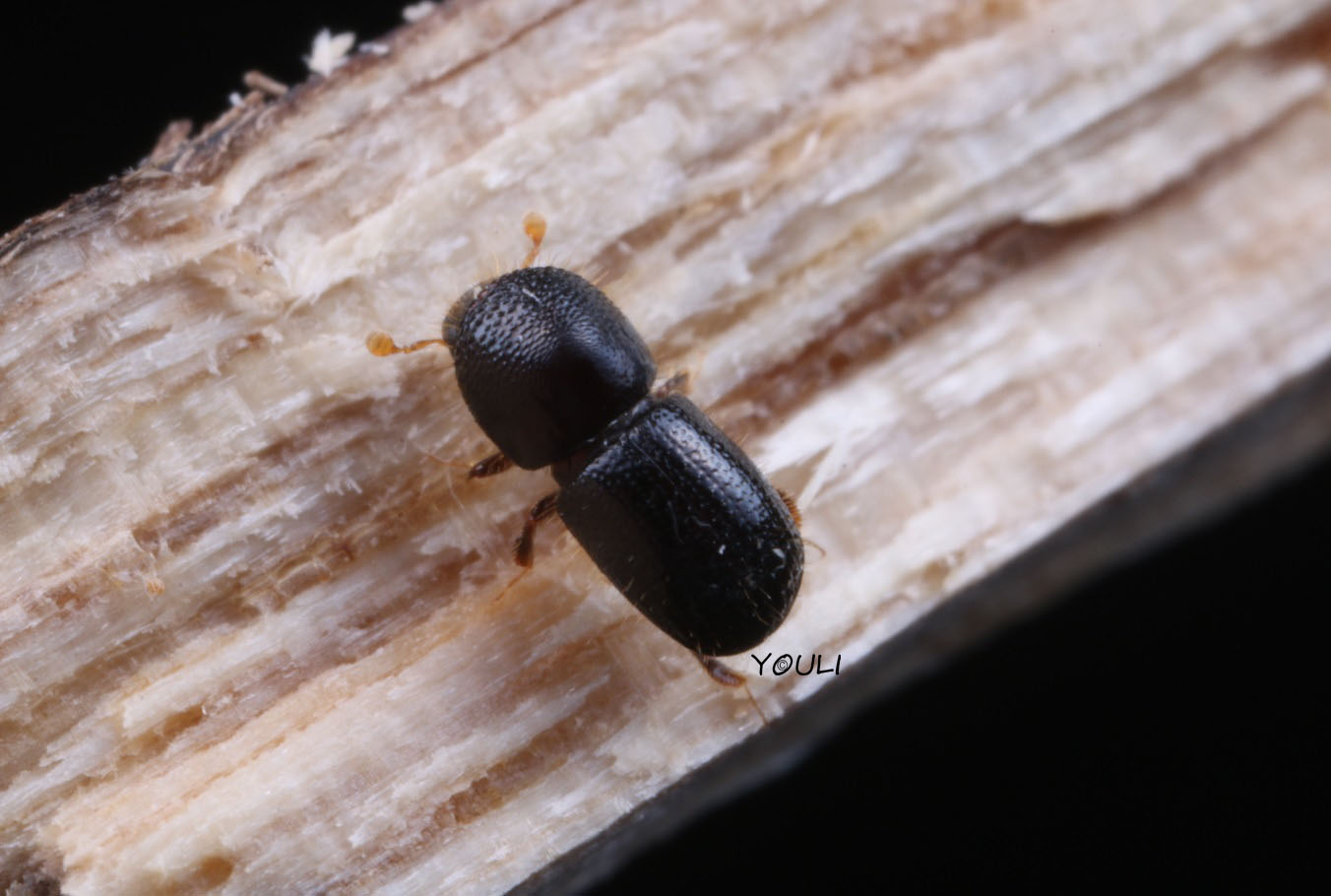
These borer beetles (Euwallacea fornicatus) are invasive species in California that were unintentionally introduced. Adults feed on symbiotic fungi. They can kill trees in large numbers.
They breed in live hosts and are a pest to economically important plants, including avocado, tea, citrus, and cacao. This small beetle can grow to 2.5 millimeters in length and are dark brown or black.
31. Argentine Ant

The Argentine Ant (Linepithema humile) is native to northern Argentina, Paraguay, southern Brazil, Uruguay, and Bolivia. It is an invasive species that was accidentally introduced by humans in North America.
Worker ants are around 2.8 millimeters in length, enabling them to squeeze through small holes and cracks. Queens can grow to 6.4 millimeters. They create a habitat in concrete wall cracks, between timbers, and in the ground. They are common in human dwellings.
They are ranked among the worst one hundred invasive species in the world. They displace native ants, threatening native inverts. The Argentine ant has been closely tied to the decline in coastal horned lizards in Southern California.
32. American Serpentine Leaf Miner
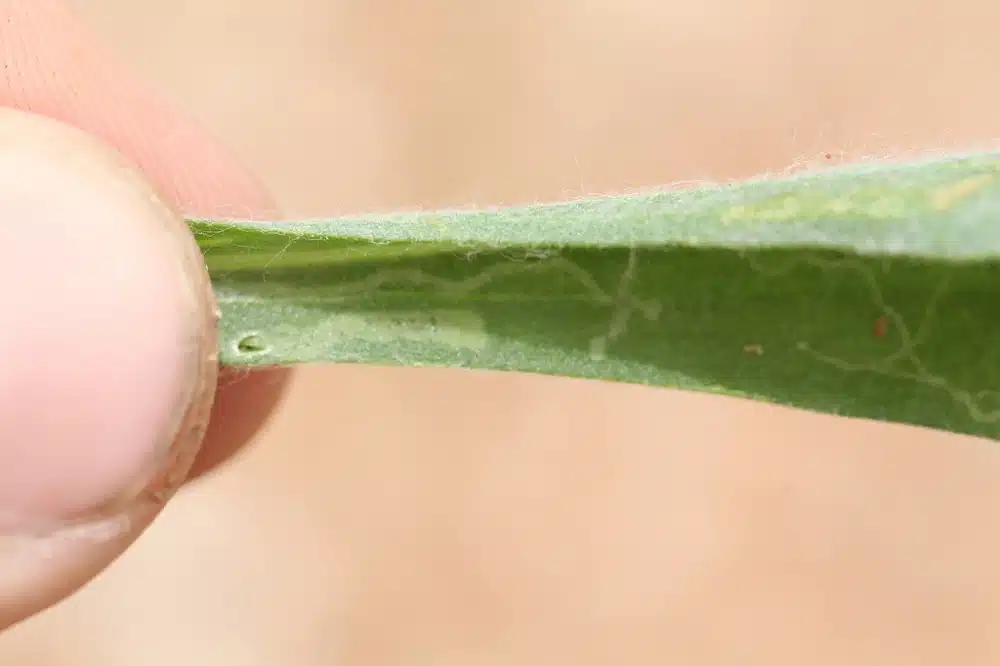
The American Serpentine Leaf Miner (Liriomyza trifolii) is a fly belonging to the Agromyzidae family. It is a damaging pest, consuming and destroying produce and plant products. They infest greenhouses and are considered an invasive species in California.
As adults, they only measure 2 millimeters. They are yellow with dark brown or gray on the thorax and abdomen. They have yellow legs. The wings are transparent with visible veins.
They are native to the Caribbean countries and have been introduced to other countries through produce export. They are resistant to certain insecticides and have been introduced accidentally by humans.
33. Greenhouse Slug

The Greenhouse Slug (Milax gagates) is dark gray or black. These slugs can grow to 50 millimeters in length and weigh up to 3308mg. They are native to Morocco and were introduced to North America and other countries throughout the world.
They are commonly found in nurseries, pastures, gardens, and greenhouses. They live in woodlands, grassy areas, and hedges.
34. New Zealand Mud Snail

The New Zealand Mud Snail (Potamopyrgus antipodarum) is a small freshwater snail. They are native to New Zealand and have been introduced to North America where they are an invasive species. Their populations reach exceptionally high densities.
They have an elongated shell with a coil of up to eight whorls. The shells vary from dark or light brown to gray. The shell can be up to 5 millimeters in height. They are usually 6 millimeters in length.
They were introduced to live game fish and spread through ship ballast water.
35. Golden Apple Snail

The Golden Apple Snail (Pomacea canaliculata) is a large freshwater snail that is native to South America. It is one of the one hundred worst invasive alien species on the world list. They have global-shaped shells with brown, black, and yellow-tan banding. They can grow to 150 millimeters in length.
This snail is a problem for rice crops. Without effective control measures being taken, they can destroy one square meter of a field in one night, leading to a fifty percent yield loss.
36. Red Imported Fire Ant

The Red Imported Fire Ant (Solenopsis invicta) is native to South America and belongs to the Mymicinae family. It was accidentally introduced to North America. These red ants have a black or brown gaster. Males are completely black.
They are common in disturbed areas, grasslands, buildings, and roads. They construct large mounts from oil with no entrance. Workers emerge far from the nest. Workers can grow to 6 millimeters
They are native to Argentina and have invaded the United States with populations found in California.
37. White Garden Snail
The White Garden Snail (Theba pisana) is native to the Mediterranean and has become an invasive species in North America. They are agricultural pests. The shell varies from white to yellow-brown with light brown markings.
The shell can grow to 25 millimeters with a 20-millimeter height. They feed on a wide range of plants, including vegetables, ornamentals, and orchard trees. They make irregular holes in the smooth edges of leaves and flowers. They feed on ripening fruits, seedlings, and young plant parks.
They have a high reproductive rate and thousands of white garden snails can gather on a single tree.
Invasive Plants of California
There are thirty invasive plants in California, including:
38. Barbed Goat Grass

Barbed Goat Grass (Aegilops triuncialis) is native to the Mediterranean and Western Asia. It is an introduced invasive species in North America. It grows to 41 centimeters in height with loose erect stems. It produces flower spikes of three to six spikelets with long, stiff awns for seed distribution.
When mature, the spikelets fall off and germinate on the ground. It can be dispersed by wind, water, or animals. It was introduced to North America in the 20th century with a great impact in California. It was introduced through the Mexican cattle trade. It invades infertile soil, causing damage to habitats, and invading endemic grasslands.
39. Australian Blackwood

The Australian Blackwood (Acacia melanoxylon) is native to South Eastern Australia. This tree can grow to sixty-six feet in height with a bore of 150 centimeters in diameter. It has gray to black bark that is scaly in appearance. The ribbed branches are angular.
The leaves are glossy, dark green, and leathery, growing to 16 centimeters in variable shapes. It has recently been listed as an invasive species in California, causing limited impact. Used as a street tree, it is now being phased out due to the damage it causes to underground plumbing and pavements.
40. Tree of Heaven

The Tree of Heaven (Ailanthus altissima) is a Chinese tree. It is deciduous, and found in temperate climates. It grows at a rapid rate and can reach forty-nine feet within twenty-five years. They live more than fifty years, with some exceeding one hundred years.
It is a noxious weed and a vigorous invasive tree. It is one of the worst invasive plants n North America. It harbors the invasive and destructive spotted lantern fly. It has smooth bark in light gray. It has stout, smooth twigs in a red-chestnut color. The leaves are heart-shaped.
41. Giant Reed

The Giant Reed (Arundo donax) is a perennial cane. It grows in damp soil and is native to the Middle East. It has been planted and naturalized in California forming on disturbed sites, sand dunes, riparian habitats, and in wetlands.
It grows to six meters in height with hollow stems. The leaves are gray-green with tapered tips. The giant reed flowers in late summer with feathery plumes. It reproduces vegetatively through fibrous underground rhizomes. These form knotted maps up to one meter under the soil.
42. Hottentot-fig

The Hottentot-fig (Carpobrotus edulis) is native to South Africa and is a creeping succulent that creates mats. It grows throughout the year with shoot segments growing more than one meter per year. They can grow to fifty meters in diameter.
The leaves are yellow to dull green with a slight curve and serrated sides at the tip. It produces yellow flowers, which open in the morning and close at night. It is believed the Hottentot fig arrived by ship in the sixteenth century. It was introduced in the early 1900s to stabilize dunes and soil on railroad tracks.
Thousands of acres were planted until the 1970s in California. It spreads through seeds. It is known to speed up coastal erosion. You will still see this plant on beaches, military bases, public and private landscapes, and along highways.
43. Yellow Star-thistle
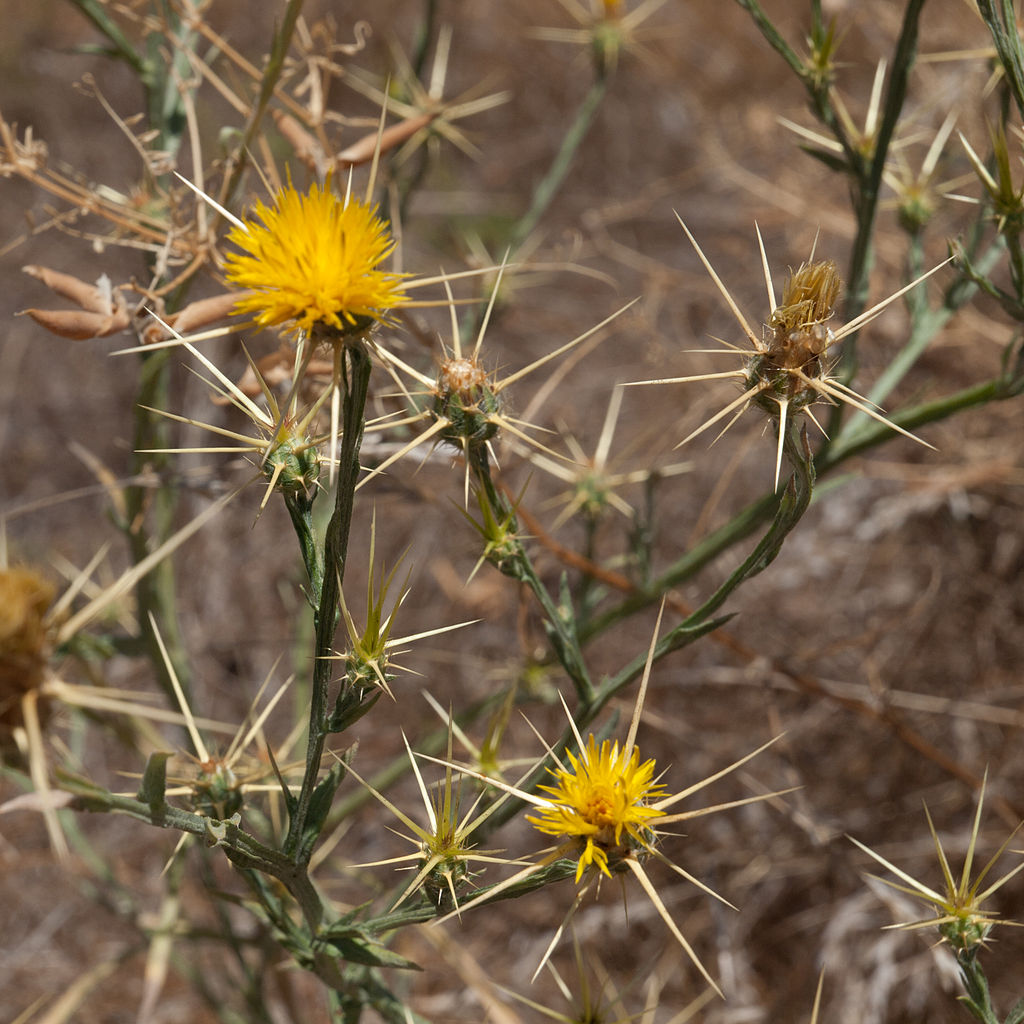
The Yellow Star-thistle (Centaurea solstitialis) is a thorny plant that is native to the Mediterranean. It is an annual herb that forms a rosette of non-spiny leaves during the vegetative stage. It produces a flowering stem during the summer.
It has lobed leaves. The stem can produce numerous flower heads, which contain up to fifty yellow flowers. The flowers use insect pollination with up to fifty seeds. It was first introduced to North America in California at the start of the Gold Rush.
It has been dispersed into agricultural fields. It has thrived with the assistance of the mowing of lawns, road development, domestic animal grazing, and wildfire breaks. It is very common in fields and vacant lots, pastures, parks, and natural areas.
44. Bull Thistle

Bull Thistle (Cirsium vulgare) is native to Europe and Western Asia. It has been introduced and naturalized in North America. It produces a lot of nectar for pollinators and is a biennial thistle that forms a rosette of leaves. Growing to 1.8 meters in height.
The green leaves are lobed and spear-shaped. The wings are 5 millimeters and are dispersed with the wind. It is a noxious weed. Regular cultivation and the uproot before seeds mature help to reduce its establishment.
45. Purple Pampas Grass

Purple Pampas Grass (Cortaderia jubata) can grow to seven meters in height. It is native to northern Andres and has been introduced as an invasive noxious weed. It has long razor-edged leaves in bunches. The top of the stem is several meters high with plumelike spikelets. The panicles are purple or pink, turning cream to white.
They are full of fruits, which develop even though the plant isn’t fertilized. Each plant produces millions of seeds annually, which are dispersed through soil transport, wind, and water. It grows in wet conditions on the moist Californian coast, where it was introduced as an ornamental plant.
It competes with native vegetation, interfering with ecosystems and habitats. It also harbors pests, including rats. The dry foliage is also a fire hazard.
46. River Red Gum

River Red Gum (Eucalyptus camaldulensis) is an Australian tree with smooth white to cream bark. It has lance-shaped leaves and groups of up to nine white flowers. It can grow to twenty meters with rough pieces of bark near the base.
The white flowers form in the summer. The limbs often fall without any warning, making it dangerous to camp or picnic near them.
47. Blue Gum

The Blue Gum (Eucalyptus globulus) is an evergreen tree from southeastern Australia. It has smooth bark with white, waxy leaves that change to glossy green leaves. It can grow to forty-five meters in height.
It has smooth bark in white or cream. It is a non-native tree that has naturalized in California.
48. Common Fig

The Common Fig (Ficus carica) is a deciduous tree that grows to thirty-three feet in height with smooth white bark and fragrant leaves. It develops a fleshy, hollow fig with unisexual flowers. The flowers are tiny and bloom inside a cup-like structure.
The fig is around five centimeters long with green skin, turning brown or purple as it ripens. The tree produces a milky sap which is an irritant to human skin.
The tree grew in California after the gold rush when it was introduced by nurseries. California became the ideal fig-producing state in the nineteenth century.
49. Tropical Ash

Tropical Ash (Fraxinus uhdei) is native to Central America and Mexico. It is planted on the streets in Mexico and the United States. It is now considered an invasive species. It is a fast-growing tree that can grow to forty meters in height with a one-meter steam diameter.
It grows in mixed mountain forests. It was introduced in California in the 1920s.
50. Canary Island Ivy

This (Hedera canariensis) is an evergreen perennial climbing woody shrub that can grow to thirty meters in height. It also grows as ground cover if there are no vertical surfaces. It uses aerial rootlets to climb, clinging to the substrate. It grows rapidly in warm climates.
It has broad dark green leaves that are leathery in texture, growing to 20 centimeters. It is often used in floral arrangements and cultivated gardens. The flowers are green and it has a round, black fruit.
Due to its rapid growth, it must be pruned regularly to manage it effectively.
51. Blue Morning Glory

Blue Morning Glory (Ipomoea indica) is a flowering plant with heart-shaped leaves and purple or blue funnel-shaped flowers. The plant is grown for ornamental purposes but is an invasive plant in California. It has become a noxious weed in numerous countries, including California.
It disperses through seeds and stems fragments. It can produce a high number of seeds. It can invade and colonize new land easily, growing over pre-existing trees and plants. It competes against native plants for nutrients, water, sunlight, and substrates.
52. California Privet

The California Privet (Ligustrum ovalifolium), or Korean private, is a flowering plant native to Korea and Japan. It is a fast-growing, deciduous, dense shrub, growing to 15 feet in height. It has thick, fleshy, green leaves.
It flowers in midsummer with white flowers with a pungent fragrance. The flowers have curled-back petals with yellow stems. It has small black or purple fruits, which are poisonous to humans. They produce thousands of fruits in favorable conditions.
It is an invasive species in California and is listed on the noxious weed list.
53. Common Horehound

The Common Horehound (Marrubium vulgare) is a flowering plant, native to Europe and Asia. It has been widely naturalized in North America. It has green leaves and can grow to 45 centimeters in height. The white flowers are in clusters on the top of the stem.
It is common in disturbed or overgrazed areas and is unpalatable to livestock. Livestock feed around the plant, leaving it, which has helped it develop and spread.
54. Common Ice Plant

The Common Ice Plant (Mesembryanthemum crystallinum) is native to Europe, Africa, and Sinai. It has glistening bladder cells of water. It can grow to 60 centimeters in length with 10-centimeter leaves. It flowers from March to October with the flowers opening in the morning and closing at night. It relies on insect pollination to disperse.
It can be found in a range of soil types including well-drained sandy soils, sand dunes, clay soils, and more. It can tolerate saline soils or nutritionally poor soils. It grows well in disturbed areas, including rubbish dumps, homestead yards, and along roadsides.
55. Tree Tobacco

Tree Tobacco (Nicotiana glauca) is a flowering plant native to South America. It is a common roadside weed and is an invasive plant in California. This small shrub or free has numerous branches, growing to over two meters.
They can reach as high as seven meters with thick, rubbery leaves. The leaves are 20 centimeters in length. It has yellow flowers and uses seeds to help it disperse and thrive.
56. Crimson Fountaingrass

Crimson Fountaingrass (Cenchrus setaceus) is a perennial grass native to East Africa. It has been introduced as an ornamental plant in North America, becoming invasive. It is drought-tolerant and fast-growing.
It can grow to three feet in height with purple flower spikes. It does well in warm, dry areas, threatening native species. It competes against native plants, making it highly invasive. It increases the risk of wildfires.
57. Castor Bean

The Castor Bean (Ricinus communis) is a perennial flowering plant reproducing with a mixed pollination system. Castor comes from the Mediterranean and is found in tropical regions, often grown as an ornamental plant.
The seeds are used for castor oil, which has numerous uses. The seeds are rich in triglycerides. Its growth and appearance are determined by its habitat. It is fast-growing and can grow to thirty-nine feet. It cannot handle cold weather.
It has glossy leaves and flowers with no petals. The male flowers are yellow-green, while the female flowers have spiked tips. It has a shiny green fruit with a large, oval, highly-poisonous seed.
58. Himalayan Blackberry

The Himalayan Blackberry (Rubus armeniacus) is native to Northern Iran and Armenia. It is planted for its berries, though in California and other states, it is an invasive noxious weed. It has biennial stems from the perennial root system.
It can grow ten meters in length, trailing along the ground. It is very common in the summer months. The berries are up to 2 centimeters in diameter, ripening to dark purple or black. Mature plants form a dense tangle of stems.
It was first introduced in Santa Rosa, California in 1885 using seeds that had been imported from India. It thrived in the new environment, but escaped cultivation and has become an invasive species. It is very difficult to contain and gets out of control very quickly.
59. Brazilian Pepper Tree

The Brazilian Pepper Tree (Schinus terebinthifolia) is a flowering plant from the cashew family, native to South America. It is a sprawling shrub with a shallow root system. It can grow to 10 meters in height.
It has upright branches. It can thrive in swamps and dunes and will grow as a semi-aquatic plant. The leaves are 22 centimeters in length. The leaves are oval and broad with fine-toothed margins.
There are two varieties, one bears pink fruit and the other bears red fruit. They are native to Argentina, Brazil, and Paraguay and have been introduced to California and six other states in North America.
60. Salt Cedar

Salt Cedar (Tamarix ramosissima) is a deciduous shrub with red stems and green foliage. It bears small pink flowers. It is exceptionally hardy, native to Asia and Europe. It is vigorous and is grown for its ornamental red stems. It is hardy and can tolerate poor soil conditions, which makes it very easy to grow.
This plant can grow to eight meters in height and five meters in width. It is used as a hedge, windbreak, and screen. It produces five-petaled pink flowers in late summer. While it can tolerate just about all soil conditions, it does prefer well-drained soil in full sun.
It is a major invasive plant in California, especially in the Desert Regions. It consumes large amounts of groundwater in riparian habitats. It is a noxious weed and has caused problems with desert riparian ecosystems.
61. Common Gorse

Common Gorse (Ulex europaeus) is a flowering plant from the British Isles and Western Europe. It grows to three meters in height and is an evergreen shrub. The young stems are green with 3-centimeter leaves.
The flowers are yellow and are produced throughout the year. The flowers have a coconut scent. The fruit is a 2-centimeter pod that is dark purple or brown. The pod has up to three black, hard, and shiny seeds. The seeds remain viable for up to thirty years.
It is a serious fire hazard and will readily catch fire and can quickly regrow from the root. It is an invasive species in California and a major problem for farmers. It competes against native plants.
62. Umbrella Thorn Acacia

Umbrella Thorn Acacia (Vachellia tortilis) is a large to medium tree, native to Africa. It can grow in a variety of conditions. In arid conditions, it remains small. It can grow to twenty-one meters in height with a canopy of leaves, which are around 2.5 centimeters in size.
It produces small white flowers which are aromatic. Seeds are in pods. It can tolerate high alkalinity, high temperatures, all soil conditions, and drought.
63. Bigleaf Periwinkle

The Bigleaf Periwinkle (Vinca major) is a flowering plant native to the western Mediterranean. It can grow to 25 centimeters and spread indefinitely. It is an evergreen and used as ground cover. It is a trailing vine that spreads along the ground with dense masses of stems. They can grow to 5 inches across.
It has gloss dark green leaves that are leathery in texture. The flowers are violet-purpose and around five centimeters in diameter. The plant flowers from early spring into the fall. It prefers moist conditions and is often seen in hedgerows, river banks, and woodlands.
64. Mexican Fan Palm

The Mexican Fan Palm (Washingtonia robusta) is a palm tree native to Mexico. It is one of the most widely cultivated subtropical palm trees in the world. It grows to twenty-five meters with one-meter leaves and a palmate fan of leaflets.
It is a fast-growing and tolerant palm tree that has naturalized in California. It can grow to more than one hundred meters in height with fan-shaped fronds that are up to five feet in length. The dead leaves drop around the trunk, rather than falling off, which increases the risk of fire hazards.
They grow quickly in well-drained soil with full or partial sun. they are wind, salt, and drought tolerant and often used in coastal planting.
65. Calla Lily

The Calla lily (Zantedeschia aethiopica) is a flowering plant native to southern Africa. It is a herbaceous perennial plant that is evergreen or deciduous. It prefers the banks of streams and ponds.
This plant can grow to one meter in height and has large arrow-shaped green leaves. It is mildly toxic to humans causing diarrhea, swelling of the lips and tongue, and stomach pain if accidentally digested. This plant has naturalized in California along the coast.
66. French Broom

The French Broom (Genista monspessulana) is a woody perennial shrub with yellow flowers. It is native to the Mediterranean region and is sometimes sold in garden stores. It is an invasive plant and noxious weed.
The plant can grow to 2.5 meters in height with slender green branches. The flowers are yellow and grouped together. It develops seeds inside a 3-centimeter pod.
It doesn’t tolerate frost and does well in warm, low-elevation areas. It becomes invasive when introduced to a new area with reproductive vigor. It is very successful in California with its warm climate. It competes against native vegetation and forms dense fields, eliminating native plants.
67. Spanish Broom

Spanish Broom (Spartium junceum) is native to the Mediterranean and Southern Europe. It is found on sunny sites with dry, sandy soils. It is a deciduous shrub that grows to thirteen feet in height with numerous stems.
The shoots are gray-green and sparse with leaves. The leaves fall away early in the spring and the summer shoots bear yellow flowers.